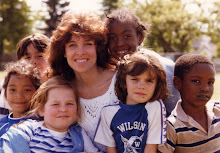It took almost a year! No luck on Google searches, or searching through my files. No luck writing several literacy researchers who I guessed might have done this work. In the end, the answer came in an email outlining a lifetime of research by Ken Goodman, my educational "grandfather"!
When Goodman began his miscue research in the 60's, one of his research studies involved 1st grade and 3rd grade students reading passages, and then reading a subset of the words in those passages on a list. The results might surprise you.
First graders could read 66% more of the words within a passage (what reading peop
 le sometimes call "connected text") than they could read on a list. Third graders could read 80% more of the words within a passage. Further, this research was conducted in a diverse, low-income community--the kind of kids that research shows get more traditional literacy instruction (worksheets, round robin reading, low-level comprehension activities), while their more advantaged peers are honing their reading skills in book clubs and discussion groups.
le sometimes call "connected text") than they could read on a list. Third graders could read 80% more of the words within a passage. Further, this research was conducted in a diverse, low-income community--the kind of kids that research shows get more traditional literacy instruction (worksheets, round robin reading, low-level comprehension activities), while their more advantaged peers are honing their reading skills in book clubs and discussion groups.(The photo above shows 3rd graders reading sight word cards in the hallway. The kids could read them all, and yet the stated goal of learning the words was to spell them accurately in their writing. I encouraged the teacher and principal to shift the focus to just that. The time in the hall, and with flashcards, didn't match their goal.)
A decade later, Lucy Calkins conducted similar research, but this time about punctuation. One class of third
 graders studied punctuation, and a second class learned about punctuation in the context of writing and talking about their writing with their teacher and peers. At the end of the year, the first group could identify and define, on average, 3 punctuation marks, while the kids who wrote as a means of learning could identify and explain the use of 8 or more, including editing marks.
graders studied punctuation, and a second class learned about punctuation in the context of writing and talking about their writing with their teacher and peers. At the end of the year, the first group could identify and define, on average, 3 punctuation marks, while the kids who wrote as a means of learning could identify and explain the use of 8 or more, including editing marks.Talking about ... or doing? Practicing words on lists or cards, or reading more of those same words within books? Naming punctuation marks, or using them to achieve one's purpose as a writer?
Therein lies the dif
 ference between what some call workshop curriculum, and the teaching of the past. M.A.K. Halliday observed, also in the 1960's, that kids learn language, learn about how language works, and use language simultaneously. They do it in their early years, and can do it in schools, too. Moreover, our job as teachers is that much easier when the direct teaching of strategies is based on what we see in the kids' work and can be immediately applied.
ference between what some call workshop curriculum, and the teaching of the past. M.A.K. Halliday observed, also in the 1960's, that kids learn language, learn about how language works, and use language simultaneously. They do it in their early years, and can do it in schools, too. Moreover, our job as teachers is that much easier when the direct teaching of strategies is based on what we see in the kids' work and can be immediately applied.I'd love to hear from readers who find a way to test this out in their own work!




When I lead others in the Primer-for-parents activity, in which adults learn to read a story written in an alternate text (i.e. words are not spelled with letters familiar to us), afterward I show them "flashcards" with a few of the words from what they just read. Only a couple of people can read the flashcards, even though everyone had just read them on the final pages of the story. I use this to make the point that flashcards provide only one set of cues (information) -- all graphophonic cues -- while what is called connected text also provides cues about the meaning and about hte structure of language. Sucessful readers use all three sets of cues (meaning, structure, graphophonic) interactively. When we use only one set of cues, as with flashcards, we rob students of two cuing systems.
ReplyDelete